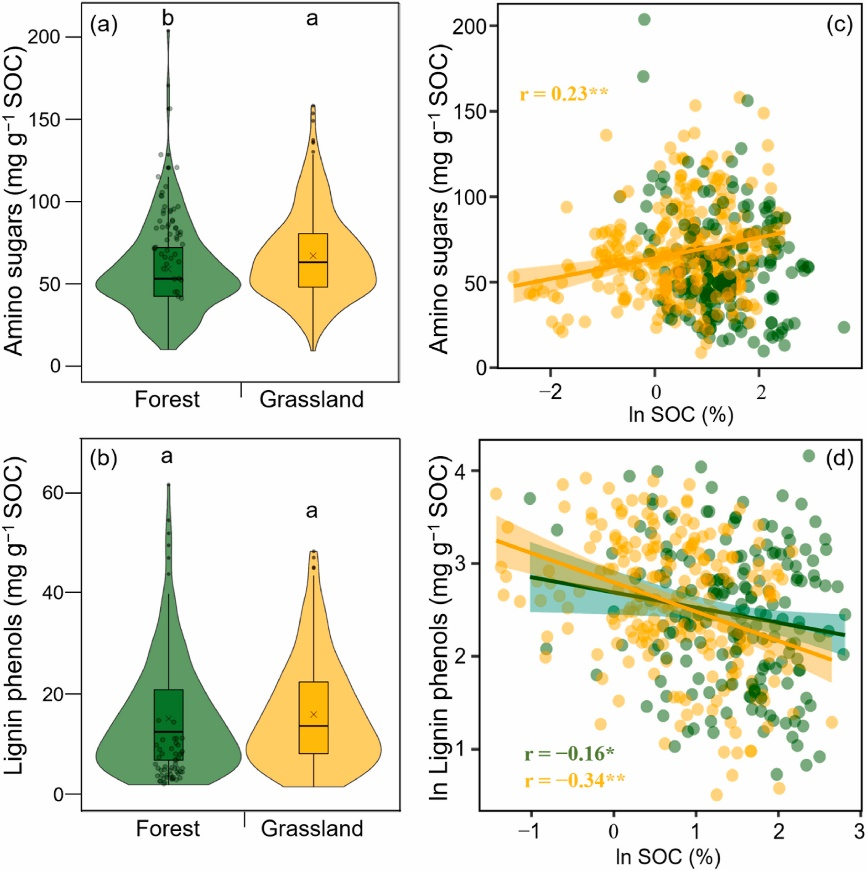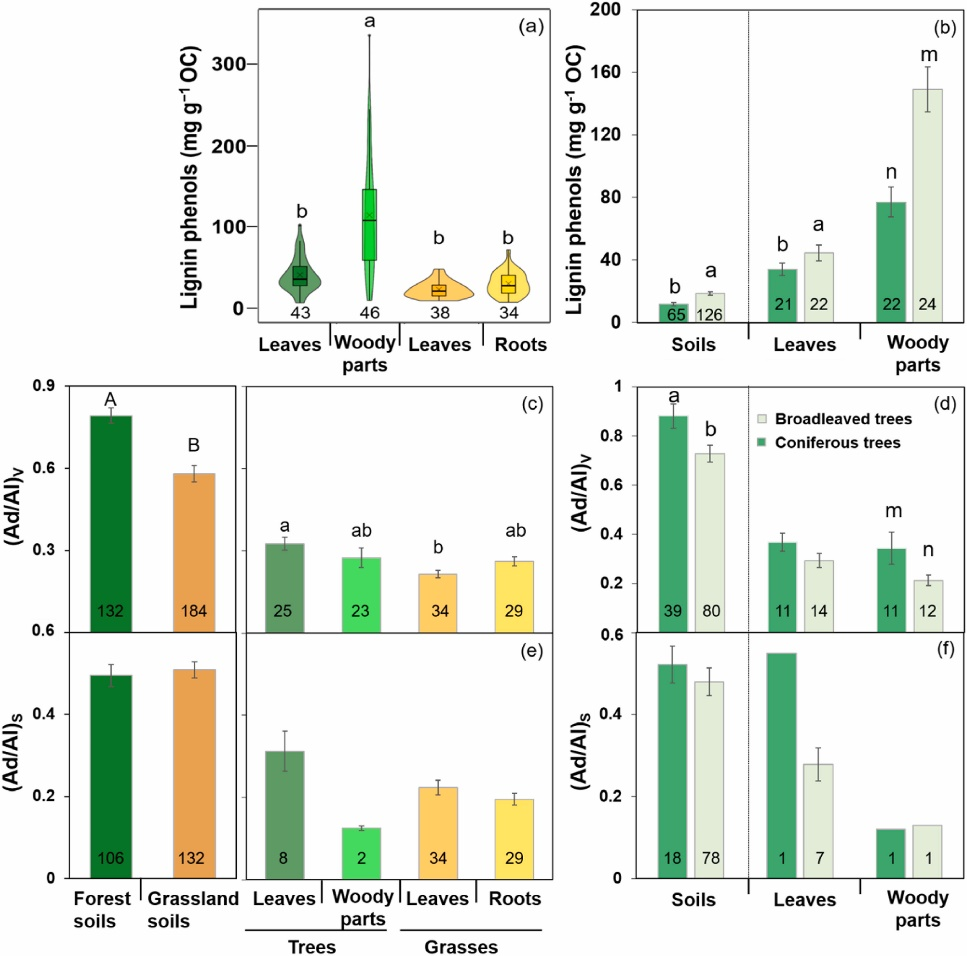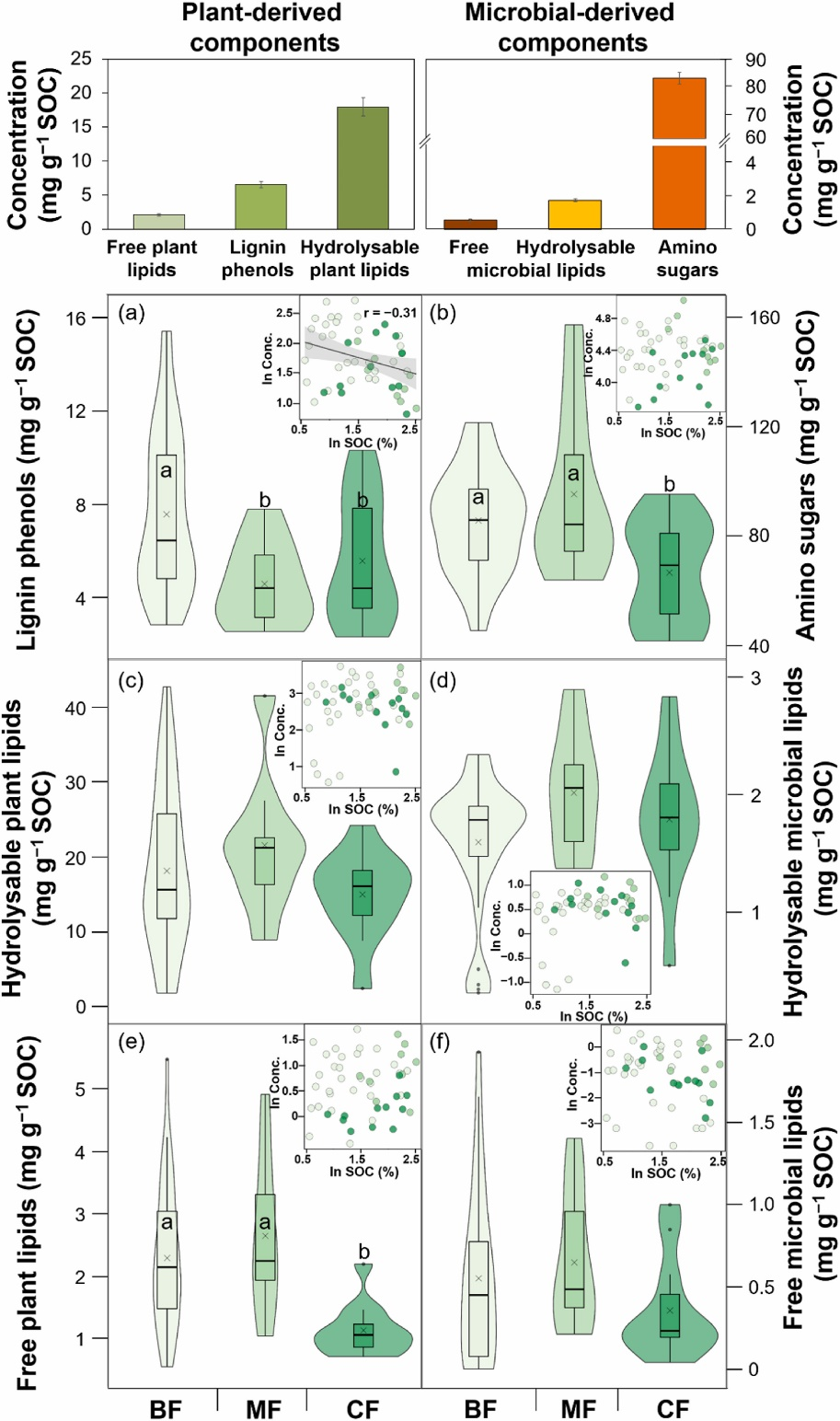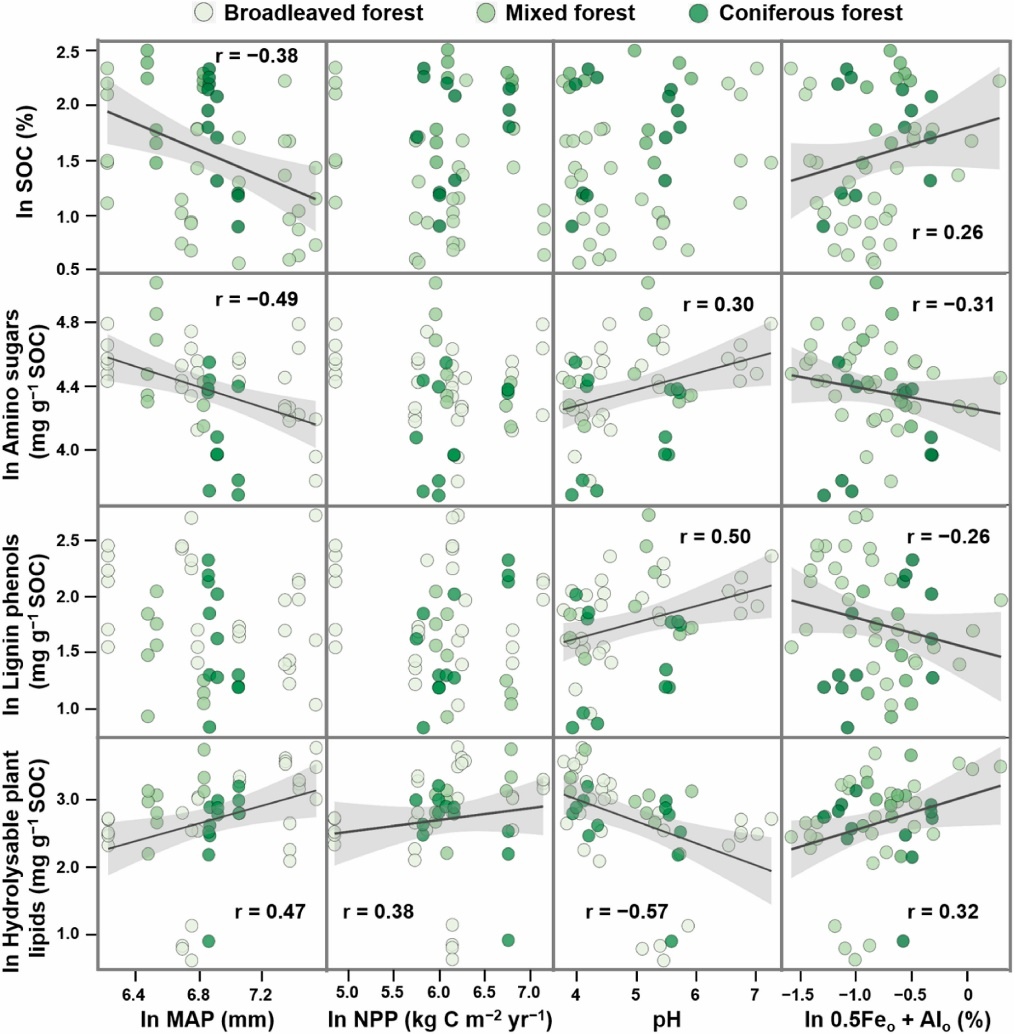基本信息:
原名:Plant-derived lipids play a crucial role in forest soil carbon accumulation
譯名:植物源脂類在森林土壤碳積累中發(fā)揮至關(guān)重要的作用
期刊:Soil Biology and Biochemistry
2020年影響因子: 7.609
在線發(fā)表時(shí)間:2022.3.24
第一作者:Guohua Dai
通訊作者:Xiaojuan Feng
第一單位:中國(guó)科學(xué)院植物研究所植被與環(huán)境變化國(guó)家重點(diǎn)實(shí)驗(yàn)室
研究背景
植物和微生物殘?bào)w是土壤有機(jī)碳的兩種主要來源。雖然最近的研究廣泛地監(jiān)測(cè)了微生物殘?bào)w在不同生態(tài)系統(tǒng)中的分布����,但植物殘?bào)w(特別是非木質(zhì)素成分)對(duì)有機(jī)碳積累的貢獻(xiàn)尚不清楚��,特別是在占全球土壤碳儲(chǔ)量50%的森林中����。填補(bǔ)這一知識(shí)空白將有助于我們更好地理解SOC積累模式及其對(duì)土地利用變化的響應(yīng)��。
研究方案
本研究采集了從南部闊葉林到北部針葉林范圍內(nèi)的中國(guó)17個(gè)主要的森林類型的0-10cm的礦質(zhì)上層土壤(Fig.1)���,分析了中國(guó)森林土壤中植物和微生物來源的脂類生物標(biāo)志物(游離脂類和可水解脂類)�����,并將其在有機(jī)碳中的分布與木質(zhì)素酚類物質(zhì)進(jìn)行了比較�����,并進(jìn)一步與全球分布森林和草地土壤中木質(zhì)素酚類和氨基糖類的分布特征進(jìn)行了比較��。綜合評(píng)價(jià)了森林類型和環(huán)境因素對(duì)植物和微生物殘?bào)w在驅(qū)動(dòng)有機(jī)碳積累中的相對(duì)重要性��。提出兩個(gè)假設(shè):(1)與草地相比����,植物源成分在森林有機(jī)碳積累中的作用更大; (2)與木質(zhì)素相比,植物源脂類對(duì)森林有機(jī)碳積累的貢獻(xiàn)更大�����,因?yàn)橹参镏悓?duì)土壤礦物質(zhì)具有較高的親和性�����。
主要研究結(jié)果
在全球尺度上�����,森林土壤微生物殘?bào)w含量顯著低于草地���,表明植物源組分對(duì)森林土壤有機(jī)碳的貢獻(xiàn)較大�����。然而�,木質(zhì)素酚類物質(zhì)與土壤有機(jī)碳含量呈負(fù)相關(guān)關(guān)系����,在土壤有機(jī)碳積累過程中并沒有發(fā)揮重要作用。相反�,在調(diào)查的中國(guó)森林中,葉源和根源的可水解脂類所占的土壤有機(jī)碳比例遠(yuǎn)高于木質(zhì)素酚���,甚至高于草地土壤�。此外�����,與木質(zhì)素酚相比���,森林土壤有機(jī)碳含量和可水解植物脂質(zhì)相對(duì)豐度均隨土壤pH的降低���、活性鐵和鋁含量的增加以及木質(zhì)素氧化(以酸醛比表示)的增加而增加。這些結(jié)果表明�,隨著木質(zhì)素分解的增加,植物脂質(zhì)和有機(jī)碳通過氧化保護(hù)積累��。
Fig. 1 Location of 17 sampling sites (a) of Chinese forests underlain by China’s vegetation map (1:1000000) and global distribution of soil lignin phenol and amino sugar measurements included in this study (b). A total of 355 and 467 data points were obtained from data reported in 47 and 51 peer-reviewed journal articles published before December 2021 for lignin phenols and amino sugars, respectively. WY: Wuying; CB: Changbai Mountain; DL: Donglingshan; TB, Taibaishan; JG: Jigongshan; GG, Gonggashan; GNJ, Guniujiang; BD, Badagongshan; HSD, Heishanding; JFL, Jianfengling.

Fig. 2 Soil organic carbon (SOC)-normalized contents of amino sugars (a) and lignin phenols (b), and their relationships with SOC contents (c–d) in the forest and grassland soils. The amino sugar and lignin phenol contents are compiled from the literature (details in Supplementary dataset Tables S2–S3) and our own data from Chinese forests (Fig. 1a). Shapes of the violin represent the distribution pattern of the corresponding data. The upper and lower ends of boxes denote the 0.25 and 0.75 percentiles, respectively. The solid line and cross in the box mark the median and mean of each dataset, respectively. Solid dots denote outliers. Hollow dots denote our own data. Letters indicate significant differences between forests and grasslands (p < 0.05). Green and yellow lines represent correlation (p < 0.05) across forest and grassland soils, respectively. Shaded areas represent the 95% confidence intervals for the regression lines. * and ** indicate significant correlation at the level of p < 0.05 and p < 0.01, respectively.

Fig. 3 Organic carbon (OC)-normalized contents of lignin phenols in plant tissues (a), broadleaved and coniferous trees and corresponding soils (b), the acid-toaldehyde (Ad/Al) ratios of vanillyl (V; c-d) and syringyl (S; e-f) phenols in forest and grassland soils and plant tissues. Symbols of the box and violin charts are defined in Fig. 2. Numbers represent the number of data. Different upper- and lowercase letters indicate significant differences between forests and grasslands and among different plant tissues (note: a and b for leaves, and m and n for woody parts), respectively (p < 0.05). All data for plant tissues are compiled from the literature.

Fig. 4 Soil organic carbon (SOC)-normalized contents of lignin phenols (a), amino sugars (b), hydrolysable plant lipids (c), hydrolysable microbial lipids (d), free plant lipids (e) and free microbial lipids (f) in the Chinese forest soils. BF, broadleaved forest (site = 10); MF, broadleaved and coniferous mixed forest (site = 3); CF, coniferous forest (site = 4). Symbols of the box and violin charts are defined in Fig. 2. Letters indicate significant differences among three forest types (p < 0.05). The bar charts give the relative abundance of plant- and microbial-derived components. The inserted graphs give the relationships of different components with SOC contents. Black line represents correlation (p < 0.05) across three forest types. Shaded area represents the 95% confidence interval for the regression line.

Fig. 5 Relationships of soil organic carbon (SOC) and the SOC-normalized contents of amino sugars, lignin phenols and hydrolysable plant lipids with the environmental variables in the forest soils of China. Black lines represent correlation (p < 0.05) across three forest types. Shaded areas represent the 95% confidence intervals for the regression lines.
Fig. 6 Relative importance of different environmental variables for the contents of SOC, amino sugars, lignin phenols and hydrolysable plant lipids in the Chinese forest soils. * indicates significant independent effects (p < 0.05). The plus (+) and minus in the parentheses represent positive and negative effects, respectively (p < 0.05).
Fig. 7 Relationships of soil organic carbon (SOC) and the SOC-normalized contents of lignin phenols and hydrolysable plant lipids with the acid-to-aldehyde (Ad/Al) ratios of vanillyl (V) and syringyl (S) phenols in the forest soils of China. Black lines represent correlation (p < 0.05) across three forest types. Shaded areas represent the 95% confidence intervals for the regression lines.
結(jié)論
研究表明�,植物源性成分在森林和草地有機(jī)碳積累中的重要性不同,并強(qiáng)調(diào)植物源脂類可能比木質(zhì)素在森林有機(jī)碳積累中發(fā)揮更重要的作用���。以往的研究主要關(guān)注木質(zhì)素對(duì)土壤有機(jī)碳的貢獻(xiàn)����,未來的研究應(yīng)更多地關(guān)注植物源脂類,尤其是森林土壤�。通過定量研究角質(zhì)和軟木脂在土壤中的分布和留存,可以揭示木質(zhì)素分析無法識(shí)別的植物成分主導(dǎo)的土壤有機(jī)碳積累的途徑和熱點(diǎn)�����。